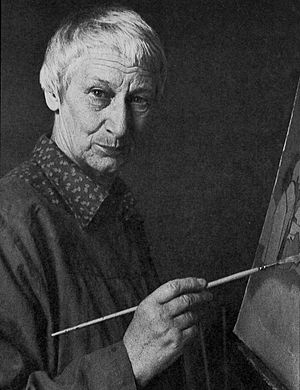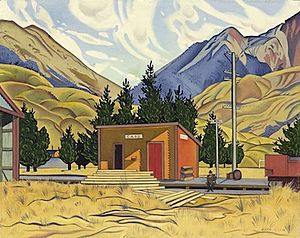Rita Angus facts for kids
Quick facts for kids
Rita Angus
|
|
|---|---|

The artist Rita Angus posed holding a paintbrush.
|
|
| Born |
Henrietta Catherine Angus
12 March 1908 |
| Died | 25 January 1970 (aged 61) |
| Nationality | New Zealand |
| Education | Canterbury College School of Art Elam School of Fine Arts Chelsea School of Art |
| Known for | Oil and watercolour painting |
| Spouse(s) | Alfred Cook 1930–1934 |
Rita Angus (born March 12, 1908, died January 25, 1970) was an important New Zealand painter. She is known as one of the top artists in New Zealand from the 1900s. Rita mostly used oil and watercolour paints. She became famous for her paintings of people (portraits) and outdoor scenes (landscapes).
Contents
About Rita Angus's Life
Early Life and Education
Henrietta Catherine Angus was born on March 12, 1908. She was the oldest of seven children. Her family lived in Hastings.
In 1921, her family moved to Palmerston North. Rita went to Palmerston North Girls' High School from 1922 to 1926. In 1927, she started studying art. She attended the Canterbury College School of Art.
Rita also took classes at the Elam School of Fine Arts in Auckland. She learned about old art styles like Renaissance and medieval art. She also got traditional training in drawing people and painting landscapes.
Marriage and Name Change
Rita Angus married Alfred Cook, who was also an artist. They got married on June 13, 1930. However, they separated in 1934 and divorced in 1939.
Rita signed many of her paintings as Rita Cook until 1946. Later, she changed her last name to McKenzie. This was her paternal grandmother's last name. So, some of her paintings are signed R. Mackenzie or R. McKenzie. But most are signed Rita Angus.
Living in Christchurch and Wellington
After teaching art for a short time in Napier, Rita lived in Christchurch. This was during the 1930s and 1940s. After her divorce, she faced money problems. She took different jobs, like teaching and drawing for The Press newspaper.
In 1950, she moved to Waikanae to get better after a difficult period. Then, in 1955, she settled in Wellington.
Rita Angus's Art Style
Rita Angus was influenced by different art styles. These included Byzantine art and cubism. She was also inspired by the English painter Christopher Perkins. His painting of Mount Taranaki showed New Zealand's unique clear light.
Rita's landscapes came at a time when many artists wanted to create a special New Zealand style. But Rita was more interested in developing her own unique way of painting. Her paintings are clear and have sharp edges.
Famous Landscapes
In the 1930s and 1940s, she painted scenes from Canterbury and Otago. One of her most famous paintings is Cass (1936). In this painting, she showed the empty Canterbury landscape. She used simple shapes and bright, unmixed colors. The style looks a bit like poster art. In 2006, Cass was voted New Zealand's most-loved painting.
In the early 1950s, Rita traveled around New Zealand. She visited Central Otago and painted her well-known piece Central Otago. After moving to Wellington in 1955, her landscapes focused on Wellington and Hawke's Bay. Boats, Island Bay is a famous painting of Wellington.
Portraits and Pacifism
Rita also painted many portraits. These include "Head of a Maori Boy" (1938) and "Portrait (Betty Curnow)" (1942). She was good at showing the true personality of the people she painted. She painted 55 self-portraits too, especially later in her life.
Rita believed in peace. This belief can be seen in her art from the 1940s. She avoided any work related to war. Rita said, "As an artist it is my work to create life and not to destroy it." She created three goddess images that stood for peace. "Rutu" is the most famous of these.
Artistic Community and International Study
For a while, Rita lived next to the artist Leo Bensemann. Their apartments became a lively place for local artists. It is said they encouraged each other in their art. Rita created some of her best works during this time. Many of these were portraits. She also drew comic art, signing them as Rita Cook.
In 1958, she won a special art fellowship. This allowed her to travel to London. She studied at the Chelsea School of Art and the Institute of Contemporary Arts. She also visited Scotland and Europe. There, she studied both modern and old European art.
In 1960, Rita spent a lot of time painting a mural. This mural is at Napier Girls' High School. It can still be seen at the front of the school hall. The mural was made to remember the girls who died in the 1931 Hawke's Bay earthquake.
Exhibitions of Rita Angus's Work
Rita Angus's paintings have been shown in many exhibitions.
- 1930: She showed her work with the Canterbury Society of Arts.
- 1932: She exhibited with The Group.
- 1940: Her paintings Cass and Self Portrait were shown. This was at the National Centennial Exhibition of New Zealand Art.
- 1957: Rita had her first solo exhibition. It was at the Wellington Art Centre gallery. She had more solo shows in 1961, 1963, 1964, and 1967.
- 1965: Her work was shown in London at the Commonwealth Institute.
- 1969: Her art was part of a New Zealand Modern Art exhibition. This was at the Smithsonian Institution in Washington, DC.
- 1982–1983: A big show of Rita Angus's work was held. It was at the National Art Gallery in Wellington.
- 2008: A major exhibition called Rita Angus: Life and Vision celebrated her 100th birthday. It was at the Museum of New Zealand Te Papa Tongarewa. The exhibition then traveled to other cities in New Zealand.
- 2022: An exhibition called "Rita Angus: New Zealand Modernist | He Ringatoi Hou o Aotearoa" celebrated 40 years of her work. It was at the Museum of New Zealand | Te Papa Tongarewa.
See also
 In Spanish: Rita Angus para niños
In Spanish: Rita Angus para niños


